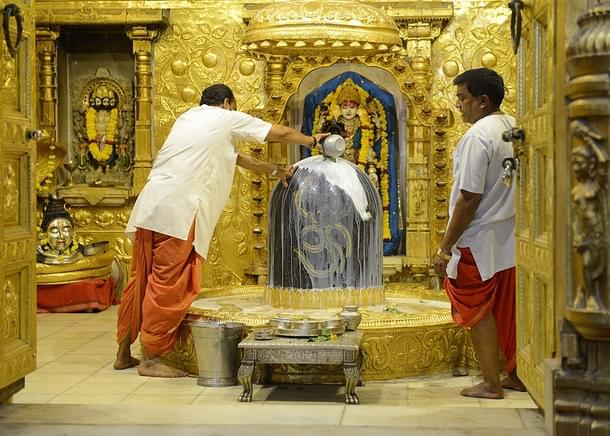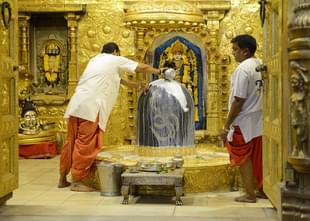Politics
Control Over Hindu Religious Appointments Is Outcome Of Wrong interpretation Of Ideals
Kanu Agrawal
May 10, 2016, 09:36 PM | Updated 09:36 PM IST
Save & read from anywhere!
Bookmark stories for easy access on any device or the Swarajya app.


The Constituent Assembly, intentionally and precisely, elevated freedom of conscience and freedom of religion into fundamental rights. The expression of this kind of freedom is not limited to a mere inward belief in a set of theological or cultural values, but it extends to the outward expression and acts done in pursuance of profession, practice and propagation of the beliefs. The Indian Constitution consciously does not create a wall separating the State and Religion in consonance with the positive brand of secularism.
Article 25 makes freedom of conscience and the right to profess, practice and propagate subject to public order, morality and health and also to the other provisions of Part III. Article 26 confers the right on every religious denomination to manage its own affairs in matters of religion and administer properties as per the law. Ostensibly, this should include the freedom of making religious appointments and of administration of properties. A brief study of the legislation and the judicial precedents paints a picture to the contrary.
Religious Appointments
The appointment to the religious ‘posts’ of Hindu temples is done in accordance with Agamas, which provide the theological basis and the rules for the appointments. The Agamas for every temple may be different as per the traditions and belief of the particular denomination. It is to be noted that the courts have dissected Hindu institutions in two parts: institutions of ‘public’ character and denominational institutions. With regard to Hindu religious institutions, the temples of ‘public character’ are already completely subject to State regulation and control under the garb of reforms under Article 25(2)(b).
The Public Trust or the Temple Committee, established under the State Acts enjoys a greater degree of control over the management and appointments, often carrying out appointments without any reference to the religious doctrines. For denominational temples, under the special doctrinal establishment of the temple, the functions and management ought to be carried out in pursuance of the doctrine of denomination (Agamas). While these appointments seemingly are a religious function which ought to be carried out by the religious denominations, the temple appointments for ‘public’ temples are done in accordance with local laws.
The State laws are ideally meant to regulate and facilitate these appointments. However, in practice, the laws often intend to control these religions appointments laying down conditions in contravention of the religious doctrines and traditions. It is at this juncture the fine balance between the constitutional freedom of religion under Article 26 and the scope of State power is tested.
While the courts recognize religious freedom in management, the freedom is limited to matters of religion. Functions and practices falling beyond the purview of essential religious practices are considered secular in nature. These secular activities can constitutionally be regulated by the State through laws. Further, through State laws and judicial precedents, the purview of these supposedly ‘secular’ aspects even within denominational Hindu temples are expanding and the matters to be constitutionally considered essential to Hindu religion are being limited and circumscribed.
This has resulted in ignoring the composite and complex nature of Hindu temples and unwarranted interference of the State in Hindu religious affairs. In a recent judgment, the Supreme Court limited the freedom of denominational temples by establishing the supremacy of constitutional parameters over and above the management as per the Agamas.
The Supreme Court has consistently held that the appointment of archakas (priests) to a temple by the trustee was essentially a secular function, ignoring that the said appointment is absolutely necessary to carry out the activities in pursuance of the essential religious beliefs. It is to be noted that the appointment of a member of a trust, which is constituted for management of secular affairs of the temple, is completely different from the appointment of priest as said appointment is for a religious duty regulated by religious rites and rituals.
The Supreme Court, in the appointment of archakas, has adopted an equity-based approach seeking aid of the reformative and regulatory language of Article 25(2)(b) and Article 26(d). The gravity of the issues arising and the perceptible magnitude of their impact on Hindu society can be best understood in the backdrop of the Dravidian Movement and the Tamil Nadu Hindu Religious and Charitable Endowments Act, 1951 and the reenacted Act of 1959.
The constitutionality of the Act of 1951 was questioned in the Shirur Mutt case wherein the court established that the religion and the secular management of the property of the Mutt are independent so that one simply exists for the other. The Supreme Court upheld the validity of most of the provisions of the Act in a trailblazing judgment, which served to define the contours of the right to freedom of religion guaranteed in the Constitution with respect to the Hindu religious institutions. The Legislature incorporated the constitutional construct of the Shirur Mutt by enacting the Act of 1959.
Subsequently, an amendment to the Act of 1959 provided that appointment to the post of archaka in any temple was not to be made on hereditary basis, which was challenged before the Courts. The Supreme Court, after examining the essentiality of the hereditary appointments in the Agamas of the said denominational Temple, took note that the Agamas merely provide for the archakas to be appointed from a particular denomination and lineage and the hereditary rule was merely a practice done on grounds of expediency. Therefore, Supreme Court negated the argument that hereditary appointment would be an “essential part” of the Agamas.
More recently, a Government Order and even an amendment in the Act prescribed that the archakas could be appointed from any caste, class or creed. The Court held that if the Agamas in question do not prescribe any group of citizens from being appointed as archakas on the basis of caste or class, the fundamental rights would not be violated. Further, the court significantly relied on the exposition of the Agamas, which excludes other Brahmins from the sanctum sanctorum and from the performance of duties of poojas.
The court implied that the exposition in Agamas does not discriminate on any constitutionally recognizable ground of caste, class, race or religion; rather it differentiates on the basis of the denominational doctrine and traditional lineage. The Court read down the amendment to the extent it was contrary to the agamas ignoring the superintendence of Agamas, which mandates the independence of such essential religious functions.
The court clarified that the Agamas did not prescribe discrimination on the basis of caste, class or creed and merely differentiated on a denominational basis. By this approach, the Supreme Court undermined the authority and superintendence of the Agamas in conducting the appointments, judged the question on broad constitutional parameters.
To further the anomalies, the court held that “constitutional legitimacy” must naturally supersede all religious beliefs or practices in contravention of the Article 16(5) and the essentiality of importance of the Agamas. The court ‘adjusted’ these constitutional standards by noting some amount of uncertainty with regard to the prescription contained in the Agamas.
In essence, the court held that the Agamas would be subject to provisions of Part III and the applicability of the Agamas could be restricted on grounds of transgression of fundamental rights. It is to be understood that the religious appointments and traditions cannot be subject to the constitutional parameters in Part III as per basic language of Article 26. Further, fundamental rights and the jurisprudence surrounding the Part III, is available to citizens/person against the State. Since the secular State must not represent any particular religious institution, the applicability of Part III to such religious matters has resulted in complete perversion of denominational religious freedoms.
The Supreme Court has also held that provisions which provide grounds for removal of priests by the trustees pending an inquiry, were constitutional and amounted to regulation for secular purposes. This implies that the State enjoy a great degree of control over both the appointment and the removal of archakas.
Ironically, in contract and labour law jurisprudence, the hire and fire test, which states that if any authority has the power to appoint and remove a person from a position, a relationship in the nature of an ‘employer’ and ‘employee’ exists. The secularization of the position of the temple priest has resulted in converting a quintessentially Hindu religious position into a mere employee of the secular State.
The intricate interplay over the societal controls and freedom between the State and the temple shapes the answers to important questions concerning the people and their religious choices. The ‘secularisation’ of Hindu religious appointments in the religious bodies has hampered the practice and propagation of Hindu ideas. It is to be understood that the noble Ambedkarian ideal of opening of Hindu religious institutions of public character to all classes of Hindus has been perverted by the State and the misinterpreted by the courts to legitimize interference in essentially religious affairs.
While the change and reforms in such affair may indeed be needed in some cases, such change must not be thrust on the religious institutions by way of State legislation. Hindu religion and all the denominations within its fold form a complex composite unit and any change that may occur must be allowed to occur socially and organically.
Kanu Agrawal is a graduate of the National Law Institute University.





